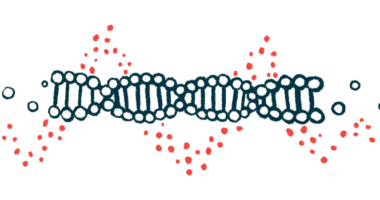Man’s Rare Genetic Defect Found To Be Cause of EDS in Daughter

A rare genetic mutation that arose in a man well before his birth was the cause of Ehlers-Danlos syndrome (EDS) in his daughter, a case study reported.
This finding marks only the second reported case of EDS being transmitted through what’s known as gonosomal mosaicism. Study researchers suggested that “further observations will allow to more accurately estimate the relevance of this phenomenon in [EDS].”
The study, “Gonosomal Mosaicism for a Novel COL5A1 Pathogenic Variant in Classic Ehlers-Danlos Syndrome,” was published in the journal Genes.
Mutations in at least 20 different genes cause the various types of EDS, with most affecting the production and function of collagens, a group of structural proteins that play an essential role in connective tissues.
Defects in collagen underlie many EDS features, such as unusually mobile joints, stretchy skin, delayed wound healing, and spontaneous tears in blood vessels, tissues, or organs.
EDS-causing mutations are usually passed from parents to children either in an autosomal dominant manner — one mutated gene copy from either parent — or in an autosomal recessive manner, in which two copies of the mutated gene, one from each parent, are inherited.
Investigators in Italy describe the case of an 8-year-old girl with EDS caused by a mutation inherited from her father who exhibited gonosomal mosaicism. Until now, there had been only one reported case of EDS caused by gonosomal mosaicism.
Genetic mosaicism occurs when a person has two or more sets of cells that are genetically different. During early embryonic development, a genetic mutation can happen in a single cell that divides to create a separate and genetically distinct group of cells and tissues.
Mosaicism can happen in somatic cells, which are all cells in the body except for germline cells, such as sperm or egg cells. As a result, the mutation cannot be passed from parents to children.
But mosaicism at the beginning of embryonic development involves somatic and germline cells — referred to as gonosomal mosaicism — and such mutations can be heritable.
The girl was born prematurely after 29 weeks of gestation via cesarean section due to maternal high blood pressure and a detached placenta. Twelve hours after her birth, she underwent successful surgery to repair small bowel perforation due to thick meconium, a newborn’s first stool.
At 2 months of age, the girl underwent a second surgery to treat damage to her retina. At that time, she was also diagnosed with cataracts in both eyes — clouding of the eye lens — facing a third surgery at 18 months (left eye) and another at 3 years old (right eye).
After falling from a chair when she was 7, considered a minor trauma, she needed surgery for a fracture to her femur, or upper leg bone, the largest bone in the body.
The girl was then referred to a clinic due to evidence of highly mobile joints, excessive skin flexibility, and delayed wound healing.
On examination, hypermobile joints and elastic skin were confirmed. Scars from previous surgeries were abnormal; she had multiple bruises on her lower limbs and had mild scoliosis, a sideways curvature of the spine. Her knee joints were deformed; she could hyperextend her elbow joints and was flatfooted.
Although she had bodywide low muscle tone and walked with a crutch, she had no deficits in strength and showed normal intellectual abilities. On both legs, her soft skin and underlying tissues had been misdiagnosed as mild lymphedema, a buildup of fluid when the lymph system is damaged or blocked. Her parents reported she easily bruised.
Lung function tests and other assessments were normal. Follow-up with specialized clinicians had been ongoing for five years, and she reported no pain, attended school with good cognitive and social skills, and weekly swimming sessions.
No one in her family had similar signs or symptoms.
Genetic analysis revealed a mutation in one of the girl’s COL5A1 gene copies — COL5A1 carries instructions for a collagen protein. Mutations in COL5A1 or COL5A2 cause most cases of classical EDS. This particular mutation was absent in all population and disease-specific databases.
There was no evidence of the mutation in the mother, but an analysis of her father’s blood samples showed a weak signal for this rare COL5A1 defect, “which suggested the presence of a genetic mosaicism,” the researchers wrote. An examination of the father did not find any skeletal, skin, or other related health problems.
Further genetic testing showed that the mutant gene copy was present in at least 3% of his blood samples, and confirmed in his saliva, hair bulbs, and nails. The investigators suggested the mosaic variant arose in the father during a very early cell division event in his development, and “was an example of gonosomal mosaicism.”
“In summary, this study reported the second case of gonosomal mosaicism for a COL5A1 deleterious variant in an unaffected father,” the investigators wrote.
This finding suggested that “the chance of parental gonosomal mosaicism may not be low, and procedures aimed at excluding this mechanism might be considered, at least in specific cases.”







